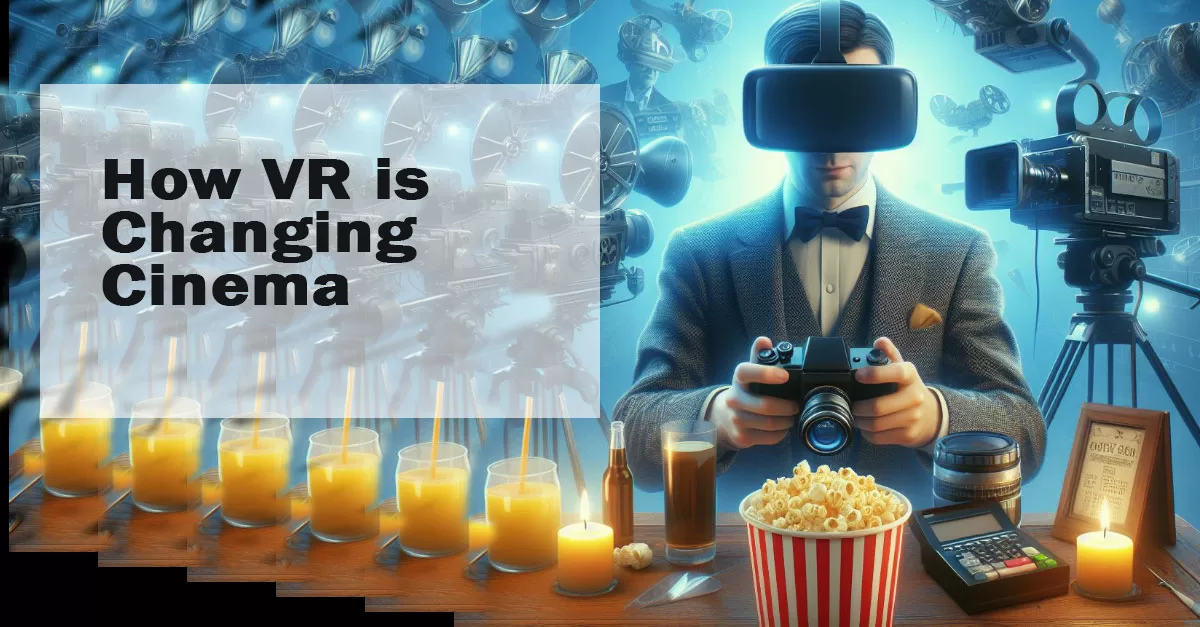A revolutionary force driving change in the film industry is virtual reality (VR). The days of watching movies in silence are over; virtual reality (VR) is redefining the experience by immersing audiences in the action and obfuscating the distinction between fact and fiction. Fans of movies, fasten your seatbelts, because we’re going to take a look at how vr is changing the cinema.
So, Lets take a look how vr is changing cinema
Enhanced Immersion:
Virtual reality headsets enable an unparalleled degree of immersion, allowing users to imagine themselves flying with dragons in “How to Train Your Dragon” or avoiding bullets in “The Matrix”. This dream is within reach thanks to reasonably priced headsets and technological advancements that reduce motion sickness and guarantee a comfortable ride. Virtual reality movie theaters go one step further by becoming interactive spaces where you can interact with the film rather than just watch it. VR allows you to actively engage with the story, whether it’s dodging debris during a spaceship chase or deciding the protagonist’s next course of action.
Simulating Sensory Experiences:
VR cinema engages all of your senses; forget popcorn and sticky floors. Innovative audio techniques such as spatial audio produce lifelike soundscapes, and haptic feedback replicates the sound of the wind rustling your hair or the earth quivering under your feet. More opportunities lie ahead, including the possibility of integrating taste and smell to further obfuscate the distinction between the virtual and the real.
Redefining Storytelling:
In virtual reality, the storytelling canvas grows. 360-degree stories draw you in and help you develop a strong bond with the characters. Now, instead of being a cold, objective spectator, you are the main character, sharing in their victories and setbacks. This deep empathy opens doors for powerful documentaries that take you to far-off places or conflict zones.
Collaboration and Innovation:
VR creates a special kind of collaboration between game developers and filmmakers. Interactive components and cinematic storytelling combine to create hybrid experiences that are visually arresting and captivating. This partnership pushes the envelope in traditional filmmaking, creating opportunities for VR-specific stories and ground-breaking, inspirational, and educational documentaries.
Overcoming Challenges:
VR cinema faces challenges, just like any emerging technology. It is important to give careful thought to health and safety issues related to vision and psychological impacts, as well as accessibility for individuals with disabilities. Creating content is still difficult because it requires a lot of money and technical know-how to get started. However, these difficulties will open the door for broader adoption as standards are developed and the technology advances.
The Future of VR Cinema:
VR film theaters have a brighter future than a thousand movie screens. User interaction will be improved by lighter, wireless headsets and eye-tracking technology. Your preferences will be catered for by artificial intelligence, which will personalize the experience. As augmented reality (AR) and virtual reality (VR) become more integrated, mixed reality experiences that combine the two will emerge. Social VR theaters will allow people to watch movies together virtually, creating virtual red carpet events and film festivals.
Also read: How technology has transformed our popular culture
Cinematic VR Experiences
- Cinematic VR experiences are a new genre of filmmaking made possible by VR technology. The audience of these immersive movies can explore amazing virtual worlds and follow the plot from any angle they choose. Cinematic VR breaks through the constraints of traditional filmmaking to provide a glimpse into amazing and fantastical worlds, from the busy streets of Tokyo to the ocean’s depths.
Expanded Creative Possibilities
- With the development of virtual reality, filmmakers can now explore new creative avenues and a world of possibilities. Filmmakers can experiment with non-linear storytelling, unusual perspectives, and unconventional narratives by creating fully immersive and interactive environments. With this newfound freedom comes the opportunity to create truly groundbreaking cinematic experiences as well as to explore novel techniques.
Transforming the Movie-Going Experience
- Virtual reality (VR) is transforming the traditional movie theater experience in addition to private home viewing. The advent of virtual reality theaters has freed spectators from the confines of a stationary seat. Alternatively, they can explore virtual lobbies, select their favorite viewing position, and even communicate with other viewers in the virtual space. VR cinema is now a social experience that is memorable and shared thanks to this transformation of the movie-going experience.
Conclusion:
Virtual reality cinema represents a paradigm shift in storytelling as much as a technological marvel. It’s an invitation to enter the film, to experience the rush of adrenaline and wind in your hair. It’s about pushing the boundaries of what a movie can be, and developing stronger bonds with people and stories. Put on your VR headset, embrace the future, and get ready to be carried away by the immersive magic of a new era in cinema.
- VR vs. Traditional Cinema: Virtual reality immerses you like never before, letting you take an active role in the narrative. Conventional film still emphasizes auditory and visual stimulation, making it a passive experience.
- Replacement of VR Cinema: It is improbable that VR will completely replace traditional cinema. Both provide distinctive experiences that accommodate various tastes.
- Motion Sickness: Although some people still feel uncomfortable, advances in technology and user-training techniques are reducing the incidence of motion sickness.
- Accessibility: Ongoing research and development of assistive technologies is necessary to make VR movies accessible to individuals with disabilities.
- Technological Obstacles: The industry needs to work together to address three major challenges: cost, content creation tools, and standardized protocols.
In this article we have shared how vr is changing cinema. Hope you liked the article.

